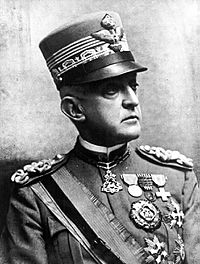Prince Emanuele Filiberto, Duke of Aosta (1869–1931) facts for kids
Quick facts for kids Prince Emanuele Filiberto |
|||||
|---|---|---|---|---|---|
| Duke of Aosta Prince of Asturias |
|||||
 |
|||||
| Duke of Aosta | |||||
| Reign | 18 January 1890 – 4 July 1931 | ||||
| Predecessor | Amedeo I | ||||
| Successor | Amedeo II | ||||
| Born | 13 January 1869 Genoa |
||||
| Died | 4 July 1931 (aged 62) Turin |
||||
| Burial | Redipuglia War Memorial | ||||
| Spouse |
Princess Hélène of Orléans
(m. 1895) |
||||
| Issue | |||||
|
|||||
| House | Savoy | ||||
| Father | Prince Amedeo, Duke of Aosta | ||||
| Mother | Maria Vittoria dal Pozzo, 6th Princess of la Cisterna | ||||
| Military career | |||||
| Nickname(s) | The Undefeated Duke | ||||
| Allegiance | |||||
| Service/ |
|||||
| Rank | Marshal of Italy | ||||
| Commands held | Italian Third Army | ||||
| Battles/wars | World War I | ||||
Prince Emanuele Filiberto Vittorio Eugenio Alberto Genova Giuseppe Maria di Savoia, 2nd Duke of Aosta (born 13 January 1869 – died 4 July 1931) was an Italian general. He was a member of the House of Savoy, a famous royal family. He was the son of Amadeo I and a cousin of Victor Emmanuel III of Italy.
Emanuele Filiberto led the Italian Third Army during World War I. His success in battle earned him the nickname "The Undefeated Duke." After the war, he became a Marshal of Italy, which is a very high military rank.
Contents
His Life Story
Emanuele Filiberto was born in Genoa, Italy. He was the oldest son of Prince Amadeo of Savoy, Duke of Aosta. His father was the second son of King Vittorio Emanuele II. His mother was Donna Maria Vittoria dal Pozzo della Cisterna.
In 1870, his father, Amadeo, became the King of Spain. However, Amadeo gave up his throne and returned to Italy in 1873. When his father died in 1890, Emanuele Filiberto became the new Duke of Aosta.
His Military Career
Emanuele Filiberto started his career in the Italian Army in Naples in 1905. He quickly became a commander.
During World War I, he was in charge of the Italian Third Army. This army became known as Armata invitta, meaning "undefeated army," because of their success. After the war, in 1926, he was promoted to the rank of Marshal of Italy. This was a very important honor.
His Death and Burial
Prince Emanuele Filiberto passed away in 1931 in Turin. He wanted to be buried in the military cemetery of Redipuglia. This is where thousands of soldiers from his Third Army were also buried.
Things Named After Him
Several places and things were named in honor of Emanuele Filiberto:
- A bridge in Rome, called the Duke of Aosta Bridge, built in 1942.
- Another bridge on the Piave River in Jesolo, opened in 1927.
- A street in Rome.
- A warship, the cruiser Emanuele Filiberto Duca d'Aosta. This ship was later given to the Soviet Union after World War II.
His Family
On 25 June 1895, Emanuele Filiberto married Princess Hélène of Orléans (1871–1951). She was the daughter of Prince Philippe of Orléans.
They had two sons:
- Amedeo, 3rd Duke of Aosta (born 21 October 1898 – died 3 March 1942). He married Princess Anne of Orléans and had children.
- Aimone, 4th Duke of Aosta (born 9 March 1900 – died 29 January 1948). He was briefly King Tomislav II of Croatia. He married Princess Irene of Greece and Denmark and had children.
Awards and Honors
Emanuele Filiberto received many awards and honors from Italy and other countries:
 Kingdom of Italy:
Kingdom of Italy:
- Knight of the Annunciation, given on 14 March 1890.
- Grand Cross of Saints Maurice and Lazarus, given on 14 March 1890.
- Grand Cross of the Crown of Italy, given on 14 March 1890.
- Grand Cross of the Military Order of Savoy, given on 28 December 1916.
- Gold Medal of Military Valour, given on 24 June 1937.

 Austria-Hungary:
Austria-Hungary:
- Grand Cross of the Royal Hungarian Order of St. Stephen, given in 1895.
- Knight of the Golden Fleece, given in 1899.
 Kingdom of Prussia: Knight of the Black Eagle, given on 17 May 1893.
Kingdom of Prussia: Knight of the Black Eagle, given on 17 May 1893. Siam: Knight of the Order of the Royal House of Chakri, given on 1 June 1897.
Siam: Knight of the Order of the Royal House of Chakri, given on 1 June 1897.
 Sweden-Norway: Knight of the Seraphim, given on 18 September 1897.
Sweden-Norway: Knight of the Seraphim, given on 18 September 1897. United Kingdom: Stranger Knight of the Garter, given on 15 July 1902.
United Kingdom: Stranger Knight of the Garter, given on 15 July 1902. Kingdom of Saxony: Knight of the Rue Crown.
Kingdom of Saxony: Knight of the Rue Crown. Spain: Grand Cross of the Order of Charles III, with Collar, given on 28 December 1923.
Spain: Grand Cross of the Order of Charles III, with Collar, given on 28 December 1923.
See also
 In Spanish: Manuel Filiberto de Saboya-Aosta para niños
In Spanish: Manuel Filiberto de Saboya-Aosta para niños

